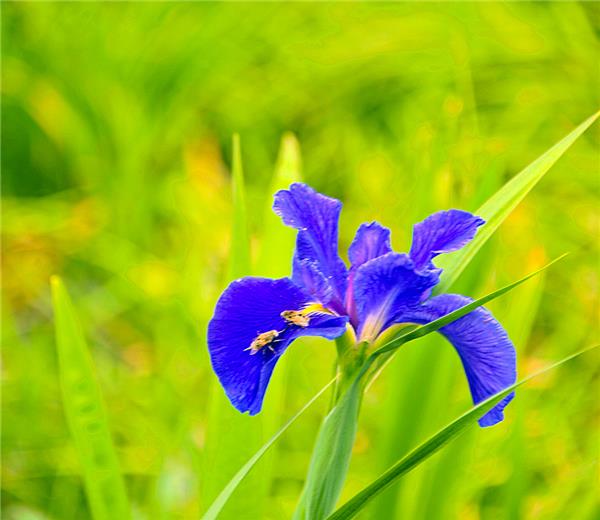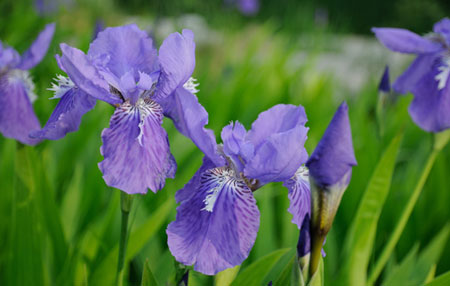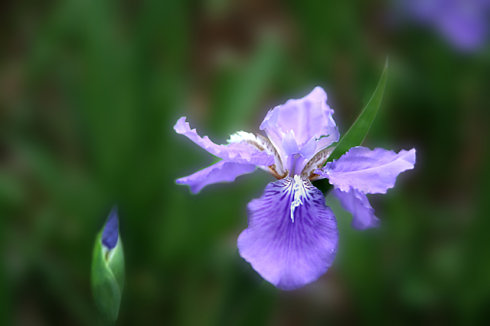[how to grow Iris] the planting method of Iris
Iris belongs to the genus Iris of Iridaceae, which is a kind of flowers with high ornamental value. Iris has a symbol of freedom and light, and it can also extract flavors to make perfume, so many people grow irises at home. So how do you grow irises?
How to grow irises
Morphological characteristics of Iris:
Perennial herbs. Rhizome long-striate or massive, transverse or obliquely extended, slender or fleshy. Leaves multi-basal, overlapping, arranged in 2 rows, sword-shaped, strip-shaped or filiform, veins parallel, midvein obvious or absent, base sheathlike, tip acuminate. Most species have only flowering stems without obvious aboveground stems, most species protrude from the ground, a few shorten and do not protrude, apical branches or unbranched; inflorescences born at the top of branches or only one flower at the top of the stem; flowers and inflorescence basally bearing several bracts, membranous or herbaceous; flowers larger, blue-purple, purple, red-purple, yellow, white Perianth tube trumpet-shaped, filiform or very short and inconspicuous, 6 perianth lobes, 2 whorls arranged, 3 outer perianth lobes, often larger than inner whorl, upper often reflexed and drooping, base claw-shaped, mostly furrow-shaped, smooth, without appendages or with cristate and bearded appendages, inner perianth lobes 3, erect or tilted outward.

When will irises be planted?
Autumn-spring planting (newly harvested bulbs)
With regard to the size of the bulb, the quality of the largest bulb (circumference more than 10 meters) is relatively high. Bulbs with a circumference of 9-10 cm are usually planted on December 1. Because it is slightly smaller than the former, the quality is slightly worse.
All kinds of balls can be used before May 15. In temperate regions, all bulbs (large or small) can be planted in a heating greenhouse on January 1.
Summer planting
There are some risks in planting irises in summer. Because the yield of iris directly depends on the temperature of the growing period. If the average temperature is expected to be higher than 25 ℃, then the planting plan will have to be cancelled. At this point, planting can only be advanced or postponed.
Autumn planting (delayed planting bulbs)
Depending on the soil temperature (preferably less than 20 ℃), cultivation can begin on September 1st, or varieties such as "BlueMagic", "Ideal" and "Prof.Blaauw" can be planted in advance in temperate zones.

Culture methods of Iris
1. Soil: clay soil that is moderately moist, well drained, rich in humus and slightly alkaline.
2. Watering: watering depends on the situation, watering once a week during the growth period of open field cultivation, and the amount of watering decreases gradually with the decrease of air temperature. it is generally advisable for the soil to be slightly dry, and do not make the soil stagnant or too wet for a long time, so as not to cause rotten roots or diseases.
3. Sunshine: Iris is full of sunlight and slightly resistant to shade. It can be cultivated in open field. Strong adaptability, general normal management will be able to grow vigorously.
4. Fertilization: base fertilizer can be applied before planting, once a year in autumn, and chemical fertilizer can be applied in the growing period.
The soil conditions needed for Iris
Irises can be grown not only in glass greenhouses or plastic greenhouses, but also in open fields. Outdoor planting with temporary mulch, or the use of mobile housing, especially in spring and autumn is feasible.

The production of cut iris can be carried out in virtually any type of soil, as long as it has good drainage, strong moisture retention, and does not harden (otherwise it will limit plant growth). A good soil structure is a basic condition, because it is necessary to plant irises with short growing periods in large quantities.
In heavy loam soil, it is recommended that peat, vermiculite or coarse sand be added and mixed with soil at a depth of about 25 meters to improve the soil.
Easy-hardening soil, after planting, can be covered with a layer of rice husks, straw, pine needles, black peat or similar materials to prevent soil hardening. Secondary methods can also be used to prevent the soil from drying quickly.

The leaves of Iris turn yellow
Iris leaves yellowing: 1. Excessive light
Iris likes to grow in a semi-overcast environment, so most of the time irises are cultivated in greenhouses. If you plant them outdoors, you should also pay attention to the lighting of irises. If the sun is too strong, the leaves of irises will turn yellow. Solution: Iris outdoor cultivation is mainly due to shade problems, when the sun is too strong, it is best to move to provide plenty of sunlight, but not too strong.
Iris leaves yellowing: 2. Too much watering
Iris is not resistant to water stains, so do not water too frequently or too much, the soil is stagnant water or too wet for a long time, resulting in iris leaves yellowing or disease. Solution: irises are watered once a week during the growing period, and the amount of water gradually decreases with the decrease of air temperature. generally speaking, the soil is slightly dry.
Iris leaves yellowing: 2. Too much watering
Iris is not resistant to water stains, so do not water too frequently or too much, the soil is stagnant water or too wet for a long time, resulting in iris leaves yellowing or disease. Solution: irises are watered once a week during the growing period, and the amount of water gradually decreases with the decrease of air temperature. generally speaking, the soil is slightly dry.
Related
- Wuhan Hospital Iron Tree Blooming Result Was Instantly Frightened by the Gardener Master
- Which variety of camellia is the most fragrant and best? Which one do you like best?
- What is the small blue coat, the breeding methods and matters needing attention of the succulent plant
- Dormancy time and maintenance management of succulent plants during dormancy
- Minas succulent how to raise, Minas succulent plant pictures
- What are the varieties of winter succulent plants
- How to raise succulent plants in twelve rolls? let's take a look at some experience of breeding twelve rolls.
- Attention should be paid to water control for succulent plants during dormant period (winter and summer)
- Watering experience of twelve rolls of succulent plants
- Techniques for fertilizing succulent plants. An article will let you know how to fertilize succulent plants.



